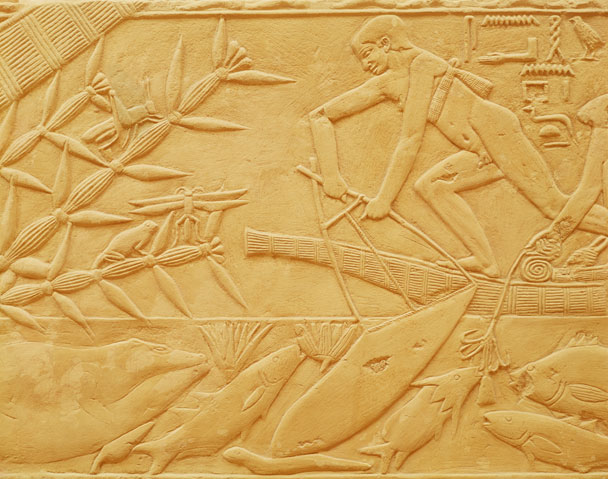Never eat the fish in Cairo. Breaking off a corner of my ginger-pear scone, I pondered this somewhat random piece of advice from my favorite professor, a punk-rock surfer turned Arabic-literature scholar who had agreed, for the price of a scone, to meet one last time before I set off for an undergraduate semester at the American University in Cairo, back in 2000. Eating breakfast pastries in the heart of Berkeley’s Gourmet Ghetto, my professor’s words of wisdom sounded strange, almost philosophical. The idea of fish in Cairo was as abstract as Kant’s notion of the sublime or the Arabic verb forms I had been studying all summer. So I filed this advice in a dusty corner of my brain, and we moved on to his favorite cafés, professors I should seek out, and confidence scams to avoid.
A few weeks later, I found myself living a few blocks from the Nile, sharing a dorm room with a minor Kuwaiti prince and a Sudanese guy who grew up down the street from Osama bin Laden’s safe house in Khartoum. When I wasn’t in class, memorizing vocabulary and analyzing modern Egyptian literature, I spent my days wandering around the city: I visited all the historic sites, cruised down the Nile, and smoked shisha at Naguib Mahfouz’s favorite café, but most of my wanderings were gustatory in nature. I tried every kind of Egyptian food I could get my hands on, and then some, from ful and tamayya to roast chicken and stuffed squab, fresh-squeezed sugar cane, kanafa, fatir, and koshari.
As much as I was enjoying myself, as comfortable as I had become in the city, something, I felt, was missing. I had made a number of friends, both visiting students like myself and Egyptians enrolled at AUC, but still I felt disconnected from the rest of the city, cut off from what I might at the time have called the real Cairo. That all changed when I met Hatim. My friend Sara, a fellow study-abroader, and I met him by chance at a bus stop near Tahrir Square, the enormous traffic circle now indelibly associated with the protests that helped topple the Mubarak regime. We ended up spending the day together, drinking tea, smoking shisha, and talking about everything in a mixture of broken Arabic and broken English. Later that same evening, Hatim called and invited us to Friday supper. His mother was a wonderful cook, he said, but I didn’t need convincing. Here was my introduction to the real Cairo, my chance to experience authentic Egyptian hospitality.
“Remember to pace yourself,” Sara advised, as we rode the second of three buses it took to get from our dorm to Hatim’s apartment in the outlying middle-class neighborhood of Nasr City. With all of her Lebanese aunts and grandmothers pushing hummus and kibbeh on her since she was old enough to chew, Sara said she had learned a few things about eating defensively. I laughed, but I would soon discover she was dead serious. As soon as we stepped into the apartment, we were greeted by the smell of fried food and by Hatim’s mother, a happy, round-faced woman who took us each by the cheeks and kissed our foreheads. Hatim was washing up, and his uncle was seated already at the dining room table, drinking a cold glass of hibiscus tea beneath a black velvet painting of Jerusalem’s al-Aqsa Mosque. Hatim’s mother bade us sit down at the table and returned to the tiny kitchen where she and Hatim’s two sisters were preparing a feast of proportions I could never have imagined.
We began with a bowl of molokhia, a thick, reedy, and quintessentially Egyptian soup with the consistency of stewed okra. I’m usually a relatively adventurous eater, especially within the vegetal world, but the texture of molokhia—made from a leafy green of the same name, which is also known, for unclear reasons, as Jew’s mallow—was too much for me to bear. After giving it my best effort, I glanced at Sara, who seemed to be enjoying her soup, then forced one more slimy green spoonful and set my spoon down, attempting to indicate my readiness for the next course without insulting anyone.
“You like the soup?” Hatim’s uncle asked, noticing my pause.
“I do,” I said, picking up my spoon. “Very much.”
“Mr. Michael likes the soup,” he called to the kitchen, and Hatim’s mother came out with the pot to top me off.
She then summoned her daughters, and they all stood over me to watch me taste it again, in their presence. I scooped up a particularly reedy spoonful and swallowed it down, patting my stomach to indicate how much I enjoyed it, and, I hope, how I wanted to save room for the courses to come.
“Eat, eat,” Hatim’s older sister insisted, in English.
Then Hatim and his uncle took up this jovial chant, and soon all of them, Sara included, were egging me on like frat brothers. They were not satisfied until I had finished the entire bowl, and even then I had to cover it with my hands to avoid another serving.
As the meal wore on, the quality of the food improved, but the quantity was unrelenting. Course after course after course, and each as large as a meal. By the second course—chopped salad and a kind of sauceless lasagna called macarona—I started pacing myself, eating defensively, as Sara had advised. I moved my food around the plate and took long sips of water. Even so, by the end of the third course—fried chicken, which they jokingly called Kenticky—I was more full than I had ever been. I understood for the first time what it would mean to eat so much you nearly split your pants. And we still had another course to go.



 Pinterest
Pinterest


